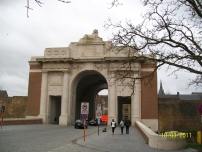| First Name: | Ernest | Last Name: | COLLETT | |
|---|---|---|---|---|
| Date of Death: | 11/11/1914 | Lived/Born In: | Dalston | |
| Rank: | Lance Corporal | Unit: | West Riding2 | |
| Memorial Site: | Menin Gate, Ypres | |||
Current Information:Age-28 Queens Road, Dalston
First Battle of Ypres Between 21st October and 22nd November, 1914 a desperate fight took place around the Belgium city of Ypres, the first of three major battles that were to be fought there during the course of the war. British troops entered Ypres in October. The 1st and 2nd Divisions plus the 3rd Cavalry Division had made their way up from the Aisne as part of the “Race to the Sea”, whilst the 7th Division came west to Ypres after Antwerp had fallen. The Germans knew that Ypres was the gateway to the Channel ports and that these were vital to Britain’s war effort so they poured reinforcements into the area. The fighting fell into three distinct battles; the Battle of Langemarck, 21-24 October, the Battle of Gheluvelt, 29-31 October and the Battle of Nonne Bosschen, 11 November. Ypres did not fall to the Germans but its defence during these two months resulted in the destruction of much of the old regular British Army. The Battle of Nonne Bosschen The battle of Nonne Bosschen on 11th November, 1914 was the final German attempt to break through the British lines around Ypres. They threw twelve and a half divisions into an attack against a nine mile front, stretching from Messines to Reutel (close to Polygon Wood). The main thrust of their attack was either side of the Menin Road where two fresh divisions, numbering around 10,000 men were thrown against eleven tired and depleted British divisions of around 4000 men. The attack was launched at 9 am after the heaviest artillery barrage yet seen and was protected by early morning mist. Astride the Menin Road the defenders were forced to give ground but more critical was the attack that penetrated the Guards Brigade line just to the north and allowed the Germans to get into Nonne Bosschen woods and threaten the artillery line. This threat was averted in the afternoon when a counter attack cleared the Germans from the wood. There was now no chance of a breakthrough and although the Germans made a few minor attacks over the next few days the First Battle of Ypres was finished. On 11th November, the Germans attacked in force along the Menin Road and forced a gap between 4th Royal Fusiliers and a French unit. To the north of the Menin Road, the 2nd West Riding battalion of 13 Brigade, 5th Division, covered the woods around Veldhoek Chateau with three companies in front and one in reserve. Their line was 300 yards back from that of 4th Royal Fusiliers on their right, with a ditch along the road forming a sort of communication trench. However this was not manned apart from a machine gun post at its eastern end. During the heavy shelling as many men as possible had been withdrawn to the shelter of the woods and when the Germans attacked there was no-one to oppose them and they were able to advance 500 yards into Veldhoek Woods in the chateau grounds. They reached the chateau but this was the limit of their success. Here they met heavy fire from the rear defences while the British artillery prevented reinforcements coming up. The German battalion that had made the attack were practically annihilated and a charge by the reserve company of 2nd West Riding drove them out of the woods. But they had no support on either flank so they dug in rather than try to retake the original trenches. 2nd West Riding suffered nearly 400 casualties, including Ernest Collett, but they had stopped and badly mauled a Prussian Guard Battalion. |
||||
| « Back to Search Results | ||||
| If you think any of the information shown here is incorrect, Click Here to submit your amends and comments | ||||




